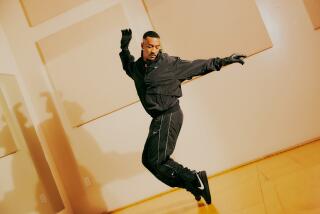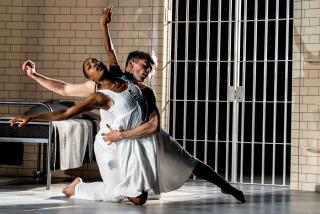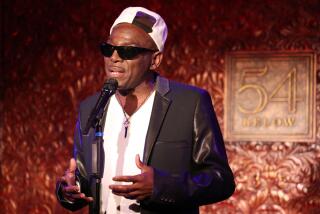Paul Taylor: Still in step at 80
Paul Taylor laughs out loud when he sums up how critics responded to his early, out-there choreography: “This terrible boy has ruined our evening!”
He can well afford to laugh. The Paul Taylor Dance Company is now 56 years old, a stable, permanent exception in the seat-of-the-pants world of modern dance. His minimalist experiments of the ‘50s long ago evolved into the audience-friendly masterworks — some lyrical, some mordant, some hilarious — that have won him scads of honors and awards, including a MacArthur “genius” grant, an Emmy and the National Medal of Arts. These days, critics are more likely to respond with rapture to the diverse dances he’s still inventing, to Beethoven, to Poulenc, to the Mamas and the Papas, even as he approaches his 80th birthday. “He continues to surprise me even when he returns to familiar themes,” says dance writer Anna Kisselgoff, who has followed his career since the 1960s.
Audiences who turn up for the 16-member company’s two performances May 8 at the Birch North Park Theatre in San Diego (part of the La Jolla Music Society’s Dance Series) could be surprised as well if they’re not familiar with the choreographer’s range. In fact, those unaware that the Taylor company dances only his works might be forgiven for assuming that the program showcases three different artists.
“Public Domain,” a 1968 piece set to a collage of recordings that are, yes, in the public domain, is by a madcap comedian. The creator of “Piazzolla Caldera,” which had its premiere in 1997, uses music by Astor Piazzolla and Jerzy Peterburshsky to feed steamy, tango-flavored couplings. And the virtuoso who made “Promethean Fire” in 2002 lives in an altogether different, elevated realm, combining majestic music by Bach with images of collapse and renewal to evoke 9/11.
The man who answers the door at Taylor’s Lower East Side apartment is none of the above — more like a kindly, soft-spoken, slightly rumpled professor. But that “terrible boy” hasn’t gone away, frequently indulging his impish instincts during a recent conversation in his light-filled living room overlooking the East River.
Give him an opening and he’ll blithely skewer a dance icon, saying of Fred Astaire, “He looks like a mosquito to me. He’s too lightweight. Just to flap your feet around is not enough.”
He’ll be no less flippant about one of his own, best-loved dances: “When you’ve seen ‘Esplanade’ this many times, you go, ‘Oh, when will it be over?’ ”
He grins as he confides that a chunk of his MacArthur loot, won in 1985, went toward six place settings of Tiffany silver — on sale, of course.
He regales you, and himself, with reminiscences of Sugar (pronounced “Shugah”), the cheerful white Yorkshire pig he lived with until she outgrew his car.
And he’s downright subversive when it comes to cigarettes, which he lights steadily as he talks: “Nobody tells you the things about smoking that help you. Cigarettes keep you awake, for one thing. They give you extra energy, for another. And now these health addicts think they’re going to die” — he breaks the word into two, long syllables — “if they even come close to a cigarette butt.”
Yes, he knows such remarks will get him into trouble. “I don’t care,” he says, sounding exactly the way he claims to feel — “like a teenager.” (If a teenager were a dance legend.)
Of course, he concedes, his body says different. He walks more slowly. He sleeps less. He daydreams more. And there’s another area that betrays his age: technology. Taylor doesn’t use a computer (“I went through about four before throwing them all out — they made me so angry.”); he doesn’t have a cellphone (“I don’t need it, I really don’t. If somebody wants to call me and it’s important, they’ll call me back.”); his music is all analog, even though the tape players he favors are no longer in production (“I’ve stocked up on second-hand ones. I can edit tapes myself with a razor blade, I can stop and start and find my place.”).
His eye remains sharp, however, and fully engaged, when it comes to dance. “I love watching my dancers,” he says. “They always are new to me, and fresh.” ( He still heads into the studio eagerly, somewhat regretful that the company’s administrators limit him to two premieres a year. (Last year’s, his 130th and 131st, were a comic romp about vaudeville, “Also Playing,” and a round robin of sexy flirtations, “Brief Encounters.”) “My main job is to crank out new dance, which I love.
“Each time I start a new piece, even if I have some plan in my mind, it’s almost as if I’ve never made a dance before. Which isn’t necessarily a bad thing. Of course, I fall back on things that I’ve tried before. But hopefully, I’ve made them look different. And I steal. I steal from other choreographers — we all do.”
Then he adds, chortling, “But I try to make it better.” (He credits Antony Tudorand his mentor, Martha Graham, as the sources of most of his thievery.)
He doesn’t always succeed, he says, maintaining that he’s had misfires that “no one will ever see again.” Still, it’s been a while since a dance went so “haywire,” he notes, that he had to ditch it and start over.
“You’re getting better,” his visitor suggests.
“Well, I’m more easily satisfied,” he responds.
He’s noticed other changes over the decades. “There are more dancers around, and they have better, stronger technique these days,” he says. But that makes the competition for work all the stiffer, and they struggle in an environment far different from environment than the one he found as a young dancer in New York.
“I was lucky,” he says. “I happened to be a big guy, and they always wanted big guys. There weren’t that many to pick from. …In those days, you could live — if you call it living — very, very cheaply. Go to Chock Full o’ Nuts or the Automat and get a sandwich. Subways were cheap, and you did a lot of walking. And when you’re young, you can live with no heat in a crummy place.”
Today’s young dancers, he suspects, have somewhat different expectations. “It’s not that they feel any less strongly about wanting to be dancers,” he says. “I think they’re committed. It’s just that, well, times have changed. I was a Depression baby.”
One thing that’s stayed the same, he notes, is that modern dance choreographers “don’t want to do what the previous generation has done. They want to find their own way.” If that should entail ruining somebody’s evening, well, what of it? It’s worked out well enough for Taylor, who’s looking forward to more years in the studio — his parents both lived into their 90s — and who knows his company, and his dances, will be around after he’s gone. Plans are in place for the company to survive him. “It will have to become more of a repertory company, with different choreographers,” he says, “and that’s fine.
“People always want something new.”
More to Read
The biggest entertainment stories
Get our big stories about Hollywood, film, television, music, arts, culture and more right in your inbox as soon as they publish.
You may occasionally receive promotional content from the Los Angeles Times.






